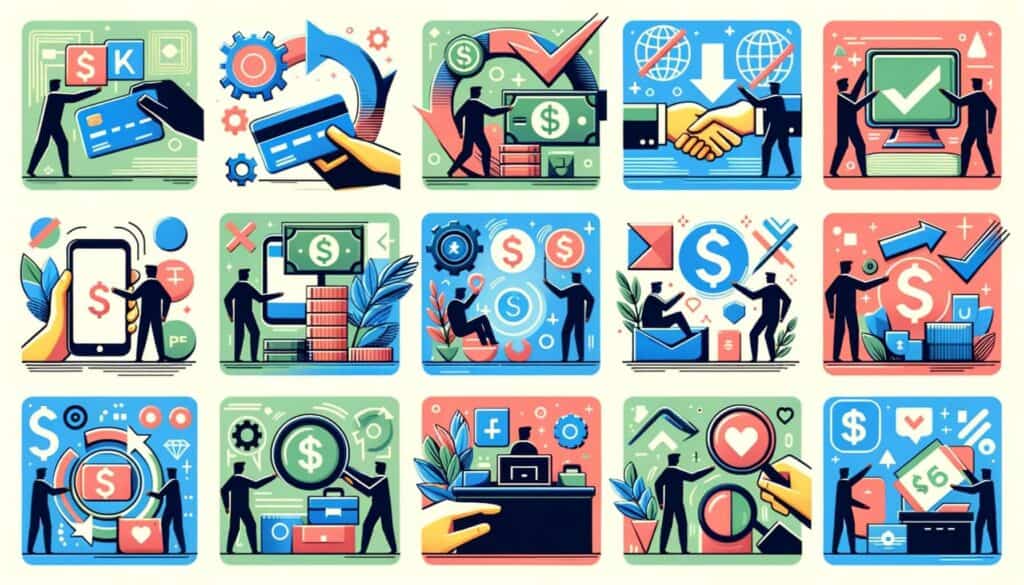
By Barbara Thomas April 23, 2025
In today’s digital age, online transactions have become an integral part of our daily lives. Whether it’s purchasing goods or services, paying bills, or transferring funds, electronic payments have made our lives more convenient. However, with the rise of online transactions, the occurrence of payment reversals has also increased. Understanding the basics of payment reversal is crucial for both merchants and consumers to navigate the complexities of the digital payment landscape.
Payment reversal, also known as a chargeback, is a process where a customer disputes a transaction and requests their bank or credit card company to reverse the payment. This can happen for various reasons, such as fraud, dissatisfaction with the product or service, or unauthorized transactions. When a payment is reversed, the funds are taken back from the merchant’s account and returned to the customer.
The Process of Payment Reversal: Step-by-Step Explanation

The process of payment reversal involves several steps and parties. Let’s delve into each step to gain a comprehensive understanding of how payment reversal works.
1. Customer Disputes the Transaction: The first step in the payment reversal process occurs when a customer decides to dispute a transaction. This can be done by contacting their bank or credit card company and providing details about the disputed transaction.
2. Bank or Credit Card Company Investigates: Upon receiving a dispute, the customer’s bank or credit card company initiates an investigation. They gather relevant information from the customer and the merchant to assess the validity of the dispute.
3. Temporary Reversal of Funds: During the investigation, the bank or credit card company temporarily reverses the funds from the merchant’s account and holds them in a separate account. This ensures that the customer is not financially burdened while the investigation is ongoing.
4. Merchant’s Response: The merchant is notified about the dispute and given an opportunity to respond. They must provide evidence, such as proof of delivery or customer communication, to support their case and prove that the transaction was legitimate.
5. Bank or Credit Card Company’s Decision: Based on the evidence provided by both parties, the bank or credit card company makes a decision regarding the dispute. If they find in favor of the customer, the payment reversal is finalized, and the funds are permanently taken back from the merchant’s account.
6. Resolution and Communication: Once a decision is reached, the bank or credit card company communicates the outcome to both the customer and the merchant. If the decision is in favor of the merchant, the funds are returned to their account. However, if the decision favors the customer, the funds remain reversed.
Common Reasons for Payment Reversal: Unveiling the Causes

Payment reversals can occur for various reasons, and it’s essential to understand the common causes to prevent them from happening. Let’s explore some of the most prevalent reasons for payment reversals.
1. Fraudulent Transactions: One of the primary reasons for payment reversals is fraudulent transactions. If a customer’s payment information is stolen or used without their consent, they have the right to dispute the transaction and request a payment reversal.
2. Dissatisfaction with Product or Service: Customers may also initiate payment reversals if they are dissatisfied with the product or service they received. This can happen if the product doesn’t match the description, is defective, or if the service was not provided as promised.
3. Unauthorized Transactions: In some cases, customers may notice unauthorized transactions on their bank or credit card statements. These could be a result of identity theft or a compromised account. To protect themselves, customers may dispute these transactions and request payment reversals.
4. Double Charges: Occasionally, merchants may accidentally charge a customer twice for the same transaction. When customers notice these double charges, they have the right to dispute them and request a payment reversal for the duplicate charge.
5. Technical Glitches: Technical glitches or errors during the payment process can also lead to payment reversals. If a customer is charged incorrectly due to a technical issue, they can dispute the transaction and request a reversal.
Types of Payment Reversal: Exploring Different Scenarios

Payment reversals can occur in various scenarios, depending on the nature of the transaction and the parties involved. Let’s explore some of the different types of payment reversals.
1. Credit Card Chargebacks: Credit card chargebacks are one of the most common types of payment reversals. When a customer disputes a credit card transaction, the credit card company initiates an investigation and reverses the payment if the dispute is found to be valid.
2. PayPal Disputes: PayPal, a popular online payment platform, also allows customers to dispute transactions and request payment reversals. PayPal investigates the dispute and makes a decision based on the evidence provided by both parties.
3. Bank Transfers: In the case of bank transfers, payment reversals can occur if the customer disputes the transaction with their bank. The bank investigates the dispute and decides whether to reverse the payment or not.
4. Mobile Payment Apps: With the increasing popularity of mobile payment apps, such as Venmo or Apple Pay, payment reversals can also occur in these platforms. Customers can dispute transactions within the app, and the payment processor investigates the dispute.
The Impact of Payment Reversal on Merchants and Consumers

Payment reversals can have significant impacts on both merchants and consumers. Let’s explore how payment reversals affect each party.
1. Merchants: For merchants, payment reversals can be a major setback. When a payment is reversed, the funds are taken back from the merchant’s account, resulting in a loss of revenue. Additionally, merchants may incur chargeback fees imposed by payment processors, which can further impact their profitability. Moreover, excessive payment reversals can damage a merchant’s reputation and lead to increased scrutiny from payment processors.
2. Consumers: Payment reversals can provide a sense of security for consumers. If they encounter fraudulent transactions or are dissatisfied with a product or service, they have the option to dispute the transaction and request a payment reversal. This can protect consumers from financial losses and ensure that they receive the products or services they paid for.
Preventing Payment Reversal: Best Practices for Merchants
While payment reversals can be challenging for merchants, there are several best practices they can implement to prevent them. Let’s explore some of the most effective strategies for merchants to minimize payment reversals.
1. Clear and Accurate Product Descriptions: Merchants should provide clear and accurate product descriptions to set proper expectations for customers. This reduces the likelihood of customers disputing transactions due to dissatisfaction with the product.
2. Prompt Customer Support: Offering prompt and efficient customer support is crucial for preventing payment reversals. By addressing customer concerns and resolving issues in a timely manner, merchants can prevent disputes from escalating to payment reversals.
3. Secure Payment Processing: Implementing robust security measures for payment processing is essential to prevent fraudulent transactions. Merchants should use secure payment gateways and encryption technologies to protect customer payment information.
4. Transparent Refund Policies: Merchants should have transparent refund policies in place to provide customers with a clear understanding of their options in case of dissatisfaction. By offering refunds or exchanges, merchants can resolve customer issues before they escalate to payment reversals.
5. Accurate Order Fulfillment: Ensuring accurate order fulfillment is crucial for preventing payment reversals. Merchants should double-check orders before shipping to avoid shipping incorrect or defective products, which can lead to customer disputes.
How to Handle Payment Reversal as a Consumer: Essential Tips
As a consumer, it’s important to know how to handle payment reversals effectively. Here are some essential tips for consumers to navigate the payment reversal process.
1. Review Transactions Regularly: Regularly reviewing bank or credit card statements is crucial to identify any unauthorized or fraudulent transactions promptly. If you notice any discrepancies, contact your bank or credit card company immediately to dispute the transaction.
2. Contact the Merchant First: Before initiating a payment reversal, it’s advisable to contact the merchant first to resolve any issues. Often, merchants are willing to address customer concerns and provide refunds or exchanges, which can prevent the need for a payment reversal.
3. Gather Evidence: When disputing a transaction, gather all relevant evidence, such as receipts, order confirmations, or communication with the merchant. This evidence will strengthen your case during the payment reversal process.
4. Follow the Bank’s or Credit Card Company’s Procedures: Each bank or credit card company has specific procedures for disputing transactions and initiating payment reversals. Familiarize yourself with these procedures and follow them diligently to ensure a smooth resolution.
The Role of Payment Processors in Payment Reversal
Payment processors play a crucial role in the payment reversal process. They act as intermediaries between merchants, consumers, and financial institutions. Let’s explore the role of payment processors in payment reversals.
1. Investigation and Mediation: Payment processors are responsible for investigating payment reversals and mediating between merchants and consumers. They gather evidence from both parties and make a decision based on the provided information.
2. Funds Management: Payment processors manage the funds involved in payment reversals. They temporarily hold the funds in a separate account during the investigation and ensure that they are returned to the appropriate party based on the outcome.
3. Chargeback Fees: Payment processors may impose chargeback fees on merchants for each payment reversal. These fees cover the administrative costs associated with the investigation and resolution process.
Frequently Asked Questions (FAQs) about Payment Reversal
Q1. What is the difference between a payment reversal and a refund?
Answer: A payment reversal occurs when a customer disputes a transaction and requests their bank or credit card company to reverse the payment. A refund, on the other hand, is initiated by the merchant and involves returning the funds to the customer voluntarily.
Q2. Can payment reversals be prevented?
Answer: While it’s not possible to prevent all payment reversals, merchants can implement best practices to minimize their occurrence. By providing clear product descriptions, offering prompt customer support, and implementing secure payment processing, merchants can reduce the likelihood of payment reversals.
Q3. How long does the payment reversal process take?
Answer: The duration of the payment reversal process varies depending on several factors, such as the complexity of the dispute and the responsiveness of the parties involved. In general, the process can take anywhere from a few weeks to several months.
Q4. Can a payment reversal be reversed?
Answer: In some cases, a payment reversal can be reversed if new evidence is presented or if the initial decision was found to be incorrect. However, reversing a payment reversal is a complex process and requires strong evidence to support the case.
Conclusion
Payment reversal is a complex process that involves multiple parties and can have significant impacts on both merchants and consumers. Understanding the basics of payment reversal, the step-by-step process, common reasons, and types of payment reversals is crucial for navigating the digital payment landscape effectively. By implementing best practices, both merchants and consumers can minimize the occurrence of payment reversals and ensure a smooth and secure payment experience.